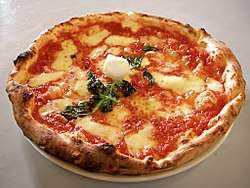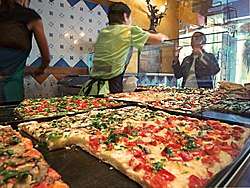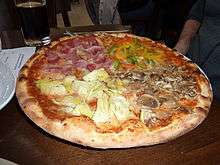List of pizza varieties by country
Pizza, a staple of Italian cuisine, has become one of the most recognizable and popular dishes worldwide. Its widespread adoption into other cuisines is traced to early 20th century.
| Part of a series on |
| Pizza |
|---|
.jpg) |
|
Pizza varieties
|
|
Cooking variations
|
|
Pizza tools
|
Europe
Italy
Authentic Neapolitan pizzas (pizza napoletana) are typically made with tomatoes and mozzarella cheese. They can be made with ingredients like San Marzano tomatoes, which grow on the volcanic plains to the south of Mount Vesuvius, and mozzarella di bufala Campana, made with the milk from water buffalo raised in the marshlands of Campania and Lazio in a semi-wild state (this mozzarella is protected with its own European protected designation of origin).[1]
According to the rules proposed by the Associazione Verace Pizza Napoletana,[2] the genuine Neapolitan pizza dough consists of wheat flour (type 0 or 00, or a mixture of both), natural Neapolitan yeast or brewer's yeast, salt and water. For proper results, strong flour with high protein content (as used for bread-making rather than cakes) must be used. The dough must be kneaded by hand or with a low-speed mixer. After the rising process, the dough must be formed by hand without the help of a rolling pin or other machine, and may be no more than 3 millimeters (0.12 in) thick. The pizza must be baked for 60–90 seconds in a 485 °C (905 °F) stone oven with an oak-wood fire.[3] When cooked, it should be crispy, tender and fragrant. There are three official variants: pizza marinara, which is made with tomato, garlic, oregano and extra virgin olive oil, pizza Margherita, made with tomato, sliced mozzarella, basil and extra-virgin olive oil, and pizza Margherita extra made with tomato, sliced buffalo mozzarella from Campania, basil and extra virgin olive oil. The pizza napoletana is a Traditional Speciality Guaranteed (Specialità Tradizionale Garantita, STG) product in Europe.[4][5]
Roman pizza, pizza in Lazio (Rome), as well as in many other parts of Italy, is available in two different styles. Take-away shops sell pizza rustica or pizza al taglio.[6] This pizza is cooked in long, rectangular baking pans and relatively thick (1–2 cm). The pizza is often cooked in an electric oven. It is usually cut with scissors or a knife and sold by weight. In pizzerias, pizza is served in a dish in its traditional round shape. It has a thin, crisp base quite different from the thicker and softer Neapolitan style base. It is usually cooked in a wood-fired oven, giving the pizza its unique flavor and texture. In Rome, a pizza napoletana is topped with tomato, mozzarella, anchovies and oil (thus, what in Naples is called pizza romana, in Rome is called pizza napoletana). Other types of Lazio-style pizza include:
- pizza romana (tomato, mozzarella, anchovies, oregano, oil)
- pizza viennese (tomato, mozzarella, German sausage, oregano, oil)
- pizza capricciosa (mozzarella, tomato, mushrooms, artichokes, cooked ham, olives, oil[7][8])
- pizza quattro formaggi ("four cheese pizza":[9] tomatoes, and the cheeses mozzarella, stracchino, fontina and gorgonzola; sometimes ricotta is swapped for one of the latter three)
- pizza bianca ("white pizza":[10] a type of bread topped with olive oil, salt and, occasionally herbs,[11] such as rosemary sprigs)
- it is also a Roman style to add figs to the pizza, the result being known as pizza e fichi[12] and pizza alla casalinga ("Housewife pizza"): a thin layer of dough which is stretched into an oiled, square "Sicilian" pan, topped sparingly with shredded mozzarella, crushed uncooked canned tomatoes, chopped garlic and olive oil, and baked until the top bubbles and the bottom is crisp.[13]
Pizza quattro stagioni is a popular style prepared with various ingredients in four sections, with each section representing a season of the year.[14][15]
Pizza pugliese is prepared with tomato, mozzarella and onion.[16]
Pizzetta is a small pizza that can range in size from around three inches in diameter to the size of a small personal-sized pizza. It may be served as an hors d'oeuvre.
Sicilian pizza is prepared in a manner originating in Sicily, Italy. Just in the US, the phrase Sicilian pizza is often synonymous with thick-crust or deep-dish pizza derived from the Sicilian Sfincione.[17] In Sicily, there is a variety of pizza called Sfincione.[18] It is believed that Sicilian pizza, Sfincione, or focaccia with toppings, was popular on the western portion of the island as far back as the 1860s.[19]
Pisan pizza (pizza pisana) is a smaller and thicker pizza baked into metal plates and traditionally served with anchovies, capers and grated Grana Padano cheese. The slices are traditionally served folded with a slice of cecina, a chickpeas cake, as street food in Pisa, its province and the nearby provinces of Leghorn and Lucca.[20]
Bill for traditional Italian pizza
There was a bill before the Italian Parliament in 2002 to safeguard the traditional Italian pizza,[21] specifying permissible ingredients and methods of processing[22] (e.g., excluding frozen pizzas). Only pizzas which followed these guidelines could be called "traditional Italian pizzas" in Italy. On 9 December 2009, the European Union, upon Italian request, granted Traditional Speciality Guaranteed (TSG) safeguard to traditional Neapolitan pizza, in particular to "Margherita" and "Marinara".[23] The European Union enacted a protected designation of origin system in the 1990s.
Malta
The Maltese enjoy eating Italian style pizza and fast-food pizzas, as well as experimenting with various toppings, including local produce. One style of fast-food pizza is the typical pizza kwadra (square pizza), which is found in Pastizzi shops (pastizzeriji), a deep-pan pizza cut into squares, generally topped with either green olives (taż-żebbuġ), hard boiled egg and cocktail sausage (bajd u zalzett), or chicken and barbecue sauce (tat-tiġieġ). A typical Pizzerija restaurant will offer a vast number of different pizza recipes, mostly based on the Italian style ones. A typical menu would include:
- Margherita: tomato sauce, mozzarella
- Funghi: tomato sauce, mozzarella, mushrooms
- Capricciosa: tomato sauce, mozzarella, mushrooms, ham, eggs, artichoke, cocktail sausages, green olives
- Quattro Stagioni: tomato sauce, mozzarella, ham, black olives, mushrooms, artichoke, peas, salami, eggs
- Vegetariana: tomato sauce, mozzarella, mushrooms, onion, (artichoke), sweet corn, green peppers,
- Quattro Formaggi: tomato sauce, and 4 assorted cheeses, generally mozzarella, Parmesan cheese, blue cheese, and goat cheese, but may vary
- Marinara: tomato sauce, mozzarella, shrimps, mussels, tuna, calamari, crab meat
- Peperoni: tomato sauce, mozzarella, peperoni
- Napolitana: tomato sauce, anchovies, olives, capers
- Hawaii: tomato sauce, mozzarella, ham, pineapple
- Maltija (Maltese): tomato sauce, goat cheese, sun dried tomatoes, Maltese sausage, onion
- Calzone (folded): tomato sauce, mozzarella, mushrooms, ham, eggs,
- Rucola: tomato sauce, mozzarella di bufala, parma ham, Parmesan shavings, rucola
- Bolognese: tomato sauce, mozzarella, minced meat, onion, (fresh tomato)
- Meat Feast: tomato sauce, mozzarella, minced meat, Maltese sausage, and other meat
- Kebabpizza: tomato sauce, mozzarella, döner kebab, onion, green peperoncini, (kebab sauce poured over after baking)
- Mexicana: tomato sauce, mozzarella, various recipes with minced beef, jalapeños, sweet corn, onion, spicy sauce and other hot ingredients
Pizza has become a household dish. Nevertheless, the traditional Maltese pizza consists of a typical Maltese ftira covered in cheese (mainly local gbejna), onions and potatoes. In fact, it is most often known simply as "ftira" and is mainly sold on the island of Gozo. Different toppings can be added, including tuna, olives, anchovies, sundried tomatoes, and even traditional Maltese sausage.
Norway
Norwegians eat the most pizza in the world according to a 2004 survey by ACNielsen 2004, 5.4 kg/year per capita. 50 million frozen pizzas were sold that year, with consumption being 22,000 tons of frozen pizza, 15,000 tons of home-baked and 13,000 tons of restaurant-made pizzas.[24] By far the most popular is the frozen pizza Grandiosa, every other pizza sold, frozen or fresh, is a Pizza Grandiosa. Since its start in 1980 the Grandiosa has been part of Norwegian modern culture and trends, going so far to be unofficially called "The national dish of Norway".
Norway also has a traditional home-made pizza called "lørdagspizza" (literally translates to "Saturday pizza"). The dough is shaped to the pan (usually rectangular), then a mix of minced meat and tomato sauce follows. Finally it is gratinated with a generous amount of cheese.[25][26]
Sweden


Pizza arrived in Sweden with Italian guest workers and became popular around 1970. After that the following wave of migrant Turks took over, and added an unmistakable hint of the Levant to the Swedish Pizza. The Swedish pizza is thicker than a Neapolitan, with a more spiced sauce, and without the characteristic crisp texture, but makes use of the traditional toppings, and most pizzerias in Sweden have Margherita, Capricciosa, and Quattro Stagioni pizzas at the top of the menu, although with altered recipes. For example, a Swedish Margherita uses Swedish hard cheese instead of mozzarella and dried oregano instead of fresh basil. The Swedish pizza has been developed with lots of innovations and styles, creating a tradition distinct from the Italian one, although some names may overlap. Occasionally pizzerias offer "Italian pizza" imitating Italian recipes in addition to the Swedish ones.
A typical Swedish pizzeria offers 40-50 different named varieties on the menu, even up to 100, and personal modifications are allowed. Also, many pizzerias also serve salads, lasagne, kebab and hamburgers, especially if there is a facility to sit and eat. Italian style restaurants often combine a restaurant menu with a pizza menu.
Some popular varieties common in most of Sweden, mostly with the same name, all having tomato sauce and cheese to start with and additional toppings:
- Africana: ham/beef/chicken, banana, pineapple, onion, curry powder
- Bolognese: minced meat, onion, (fresh tomato)
- Calzone (folded): ham
- Capricciosa: mushrooms, ham
- Ciao-ciao (folded): beef, garlic, (onion)
- Frutti di mare: tuna, shrimp, mussels
- Hawaii: ham, pineapple
- Kebabpizza: döner kebab, onion, green peperoncini, (kebab sauce poured over after baking)
- Marinara: shrimp, mussels
- Mexicana: various recipes with minced beef, jalapeños, onion, spicy sauce and other spicy ingredients
- Napolitana: anchovies, olives, capers
- Quattro Stagioni: ham, shrimp, (mussels), mushrooms, artichoke
- Vegetariana: mushrooms, onion, (pineapple), (artichokes), (asparagus), (red bell pepper)
- other varieties with filet of beef or pork and béarnaise sauce and onion
Perhaps the most extreme pizza in Sweden is the Calskrove or Calzskrove (a portmanteau of calzone and "skrovmål" meaning "big meal" but also Northern slang for "hamburger meal"), sold at some pizzerias in northern Sweden, a complete meal of a 150 or 250 grams of hamburger with bread, all regular toppings, and chips (french fries), baked into a regular Calzone with ham as well.[27]
One of the most popular types of pizza in Sweden since the 1990s is kebab-pizza, and a song in the Swedish Melodifestivalen 2008 was "Kebabpizza slivovitza". The invention is most likely the result of the common tendency of pizza bakers to create their own flagship compositions and novel flavors, using whatever might be available in their kitchen. In recent years one can find pizza with fresh lettuce or chips (French fries) put on top after baking. The amount of topping compared to the crust is rather high by international standards.
The typical side order with Swedish pizza is a free "pizza salad". 1969 Giuseppe "Peppino" Sperandio opened "Pizzeria Piazza Opera", one of the first restaurants only serving pizza in Stockholm, Sweden. Sperandio was born in northeast Italy where a cabbage salad called "kupus salata" was a very common dish, from bordering country Croatia. This salad from his childhood, was offered as a free side dish. Eaten, while waiting for the pizza to be baked. Sperandio became Stockholm's pizza king and had during his heyday more than 30 pizza restaurants. The pizza salad is made with shredded cabbage, coarse pepper and sometimes red bell pepper, slightly pickled (fermented) in vinaigrette for a few days.
In general, Swedish pizzerias are private enterprises and not franchise, often owned as a family business by immigrants, but very seldom Italians. Of international restaurant chains only Pizza Hut is well established, although Vapiano has a few restaurants in Stockholm, and Domino's has been trying to establish itself in southern Sweden since 2008.[28] Many pizzerias offer affordable (about 1-2 € total, or free with large order) home delivery in less than 30 minutes, and many are connected to an online ordering service. The take-away price of one standard size (30 cm) pizza is 5 to 8 € depending on topping, about double that for a "family pizza" of twice the size by weight, and about half that for a "children's pizza" (mostly served in restaurants). Pizza has become a staple food in Sweden (1,1 kg/year), although most people prepare their own food, as home cooking skills generally are good, and is largely considered as an acceptable occasional fast food alternative to a proper meal.
United Kingdom
Since the 1980s, a wide variety of pizzas ranging from fairly authentic Italian to American style to the mass-processed varieties are widely available, and pizzas are also commonly made at home with children using local substitutions such as bacon for prosciutto and cheddar for mozzarella. Dough bases vary widely from homemade scone doughs to thin Roman-style and thick American stuffed-crust types. The typical British high-street now has a variety of international Italian- and American-style pizza chains, including homegrown chains PizzaExpress, Strada, and Prezzo as well as Domino's, Pizza Hut, and Papa John's alongside much more authentic, independent, often Italian-run restaurants with wood-fired ovens, which can be found all over the country. Unique spicy varieties enjoy some popularity, including Chicken tikka masala or other curry toppings, chili pizzas, and a typical mid-range restaurant or takeaway will usually have versions of such standard "Italian-American" combinations as 'Hawaiian' (ham and pineapple), 'Pepperoni' (spicy salami), 'Meat Feast' (a mix of meats and salami), and 'Vegeteriana' options. Non-Italian varieties can be found too, particularly in larger cities such as London, for example, lahmacun called 'Turkish pizzas', or Alsatian 'Flammkuchen'. In some parts of Scotland you can get a deep-fried pizza from Fish and Chip shops. A frozen pizza, whole or half, is dipped in batter and deep fried, and usually served in the same manner as any other fried item from these shops.
Iceland
While Iceland has many traditional American and Italian style pizza toppings, bananas are a common topping in both Iceland and Sweden.[29]
Russia
Pizza has only been known in Russia since the end of the 20th century. At the turn of the millennium, the first original Italian pizzerias opened in Russia. After that, pizza became a cult phenomenon. In Russia, high-class ingredients are often used as a topping. For example, the pizza is topped with caviar, salmon, beef fillets or truffles. A well-known Russian variant is the so-called 'Москва' (pronounced 'Moskva') or Moscow Pizza. It is topped with tomato sauce, cheese, four types of fish fillet, roe, onions and herbs.[30]
Asia
China
The presence of pizza restaurant chains in China has contributed to a significant increase in pizza consumption in the country.[31] Pizza Hut opened its first store in China in 1990,[32][33] and Pizza Hut and Domino's Pizza both expanded in the Chinese market in the 2000s.[34] In order to fit with China's market demand and national culinary peculiarities Pizza Hut modified their pizza recipes, including local ingredients, such as crab sticks, tuna, soy sauce and corn.[35] As of 2019, Pizza Hut had over 2,000 stores in China.[36]
India
Pizza is an emerging fast food in India.[37] Domestic pizza brands include U.S. Pizza, Smokin' Joes and Pizza Corner. Branded pizza is available in most cities in India. Pizza brands feature greater "recipe localization" from pizza makers than many other markets such as Latin America and Europe, but similar to other Asian pizza markets. Indian pizzas are generally spicier and more vegetable-oriented than those in other countries. For instance, oregano spice packs are included with a typical pizza order in India instead of Parmesan cheese.[37] In addition to spicier and more vegetable-oriented ingredients, Indian pizza also utilized unique toppings. For example, a pizza topping unique to India would be pickled ginger.[29]
Pizza outlets serve pizzas with several Indian-style toppings, such as tandoori chicken and paneer. More conventional pizzas are also eaten. Pizzas available in India range from localized basic variants, available in neighborhood bakeries, to gourmet pizzas with exotic and imported ingredients available at specialty restaurants.
Indonesia

In Indonesia, Pizza Hut is the largest pizza chain restaurant, first entering Indonesia in 1984,[38] followed by Domino's Pizza and Papa Ron's Pizza.[39] Popular pizza recipes such as meat lover's with pepperoni, tuna with melted cheese, and beef blackpepper exist in Indonesia. Those recipes originated either from United States or Italy, thus deriving ultimately from a western counterpart.
However, there are also Asian eastern pizzas which includes Indonesian fusion pizza that combine Indonesian favourite as pizza toppings — such as satay,[40] balado and rendang.[41]
- Balado pizza, spicy hot balado chili pepper pizza, chicken or beef.[41]
- Rendang pizza, spicy and savoury beef rendang pizza.[41]
- Satay pizza, beef or chicken satay pizza with peanut sauce.[40]
Other than Indonesian fusion, other Asian fusion pizza are also known in Indonesia, including:[42]
- Tom Yum pizza, Tom Yum flavour pizza from Thailand
- Bulgogi pizza, Bulgogi flavor pizza from South Korea
- Kimchi pizza, Kimchi flavor pizza from South Korea
- Tikka Chicken pizza, Chicken tikka flavour pizza from India
- Peking Duck pizza, Peking duck flavour pizza from China
- Salmon Teriyaki pizza, Teriyaki flavour pizza from Japan
Japan
American pizza chains entered Japan in the 1970s (e.g. Shakey's Pizza and Pizza Hut 1973, Domino's pizza in 1985). The largest Japanese pizza chain is Pizza-La. Local types of pizza are popular, with many using mayonnaise sauces, and sometimes other ingredients such as corn, potatoes, avocado, eel, or even honey or chocolate (as in dessert). "Side orders" also often include items such as french fries, fried chicken, and baked pasta, as well as vegetable soups, green salads, desserts, and soda or Japanese tea.[43] There is also a strong tradition of using Tabasco sauce on cooked pizzas.
Pizza toppings in Japan also differ from those found in the United States. One of the unique pizza toppings found in Japan is squid. While seafood may be found on pizzas in most markets worldwide to some extent, having squid as the focal ingredient is unique to Japan.[29]
Local crust variants also exist, for instance mochi pizza (crust made with Japanese mochi cakes).[44][45] Traditional pizza served in Italian-style restaurants are also popular, and the most popular pizza chain promoting Italian style artisanal pizza is Salvatore Cuomo. The Italian association Associazione Verace Pizza Napoletana also has an independent branch in Japan.
Korea
Pizza is a popular snack food in South Korea, especially among younger people. Major American brands such as Domino's, Pizza Hut, and Papa John's Pizza compete against domestic brands such as Mr. Pizza and Pizza Etang, offering traditional as well as local varieties which may include toppings such as bulgogi and dak galbi. Korean-style pizza tends to be complicated, and often has nontraditional toppings such as corn, potato wedges, sweet potato, shrimp, or crab. Traditional Italian-style thin-crust pizza is served in the many Italian restaurants in Seoul and other major cities.
North Korea's first pizzeria opened in its capital Pyongyang in 2009.[46]
Malaysia
Pizza restaurants in Malaysia include Domino's, Pizza Hut, Papa John's, Canadian 2 and 1 pizza, Jom Pizza, and Sure Pizza. There have been several small pizza businesses run by locals, especially in night markets.
Nepal
Pizza is becoming more popular as a fast food in the urban areas of Nepal, particularly in the capital city, Kathmandu, which has several restaurants serving pizza. With the opening of international pizza restaurants, pizza's popularity and consumption has markedly increased in recent times. Common pizza types include mushroom pizza, chicken pizza and paneer pizza.
Pakistan
The first pizzerias opened in Karachi and Islamabad in the late 1980s, with Pappasallis serving pizza in Islamabad since 1990. Pizza has gained a measure of popularity in the eastern regions of Pakistan, namely the provinces of Sindh, Punjab, and Azad Kashmir, as well as the autonomous territory of Gilgit-Baltistan. Pizza has not penetrated into western Pakistan; of the remaining provinces and territories of Pakistan, only one (Khyber Pakhtunkhwa) has seen much of the dish, in the form of a single Pizza Hut in Peshawar.[47] Chicken Tikka and achari chicken pizzas are popular. In the regions where pizza is known, spicy chicken and sausage-based pizzas are also very popular, as they cater to the local palate.
Thailand
The Pizza Company Thailand introduced durian pizza in 2018 to mixed reviews.[48][49] It bears mention however that Thai-style pizzas, in homage to Thai cuisine, also appear in the US and elsewhere with peanut-based sauces and ingredients like tofu, bean sprouts, shredded carrots, basil or cilantro, shredded green beans, scallions, and similar items.
Middle East
Iran
Israel
Many Israeli and American pizza stores and chains, including Pizza Hut and Sbarro, have both kosher and non-kosher locations. Kosher locations either have no meat or use imitation meat because of the Jewish religious dietary prohibition against mixing meat with dairy products such as cheese. Kosher pizza locations must also close during the holiday of Passover, when no leavened bread is allowed in kosher locations.[50] (However, many have found solutions by offering a potato starch-based dough.) Some Israeli pizza differs from pizza in other countries because of the very large portions of vegetable toppings such as mushrooms or onions, and some unusual toppings, like corn or labane, and middle-Eastern spices, such as za'atar. Like most foods in Israel, pizza choices reflect multiple cultures, since people from the former Soviet Union and Europe, plus Israeli-born descendants and Ashkenazi Jews, account for 50% of the Jews in Israel.[51]
Turkey
Pizza establishments in Turkey are a mixture of local restaurants, local chains (e.g. Pizza Max), and international chains like Pizza Hut, Domino's Pizza, Little Caesars, and Sbarro. While most combinations of toppings reflect common ingredients found in the US and Italy, there are additional ingredients available that cater to traditional tastes as well, such as minced beef, spicy Sucuk sausage, cured meats like Pastırma, cheeses like Kaşar and Beyaz, and local olives and herbs. With the exception of some restaurants, pork products like ham and bacon are not available, which are substituted with beef, chicken, or lamb equivalents.
Pizza has several equivalent or similar dishes in traditional Turkish cuisine, such as Black-Sea-style or Bafra-style Pide and Lahmacun, which adds to the popularity of the dish across Turkey.
North America
United States
In 1905, the first pizza establishment in the United States was opened in New York's Little Italy.[52] Due to the influx of Italian immigrants, the U.S. has developed regional forms of pizza, some bearing only a casual resemblance to the Italian original. Chicago has its own style of a deep-dish pizza and New York City's style of pizza are well-known. New York-style pizza refers to the thin crust pizza popular in the states of New York, New Jersey, and Connecticut. Philadelphia provides sauce on top of the cheese; St. Louis and other Midwestern pizzas use thin crusts and rectangular slices in its local pizzas. Detroit-style pizza is a square pizza that has a thick deep-dish crisp crust, and is generally served with the sauce on top of the cheese. The square shape is the result of an early tradition of using metal trays originally meant to hold small parts in factories. The jumbo slice is an oversized New York-style pizza sold by the slice to go, especially in the Adams Morgan neighborhood in Washington, D.C. The white clam pie is a pizza variety that originated at the Frank Pepe Pizzeria Napoletana restaurant in New Haven, Connecticut.[53] Barbecue pizza was first made at Coletta's in Memphis, using pulled pork and barbecue sauce, now popular in the Southern United States. In California the barbecue chicken pizza is popular, first invented by Ed LaDou in 1985.[54]. The BBQ burnt end pizza can be found in Kansas City.
Canada

Canada has many of its own chains, both national and regional, and many distinctive regional variations and types of pizza resulting from influences of local Canadian cuisine.
The "Canadian pizza" toppings typically include tomato sauce, mozzarella cheese, bacon, pepperoni, and mushrooms; variations exist[55]); this recipe is also known internationally by that name.[56] The typical preparation of the same recipe is often referred to in Québécois as pizza québécoise.[57]
Poutine pizza is one variety that can be found sporadically across the country, and adaptations of this item have even been featured in upscale restaurants.[58]
Atlantic Canada has several unique varieties, which have spread to other parts of the country as people migrate for work. Donair pizza is inspired by the Halifax fast food of the same name, and is topped with mozzarella cheese, donair meat, tomatoes, onions, and a sweetened condensed milk-based donair sauce.[59] Garlic fingers is an Atlantic Canadian pizza garnished with melted butter, garlic, cheese, and sometimes bacon, with the round sliced into fingers and served with donair sauce.[60] Pictou County Pizza is a variant of pizza unique to Pictou County in Nova Scotia; this pizza has a "brown sauce" made from vegetables and spices instead of red tomato sauce.[61][62]
The predominantly francophone Canadian province of Quebec has its specialties. One is the "all dressed": tomato sauce (a little spicy), pepperoni, onions, green pepper slices, and mushrooms.[63] The poutine pizza variety is topped with French fries, light gravy, and fresh mozarella curds.[64]

According to a number of news outlets, the Hawaiian-style (tomato sauce, ham and pineapple) is a Canadian invention, originating at the Satellite Restaurant in Chatham, Ontario.[65][66][67][68][69] Sam Panopoulos, owner of Satellite, first concocted the Hawaiian pizza in 1962. By that time Satellite had already started serving Canadian Chinese food and Panopoulos thought people would like a similar sweet and savoury flavours together so he took a can of pineapple and tossed the fruit onto a pizza.[70]
Pizza in the southwestern Ontario city of Windsor is identified by its use of shredded pepperoni and mozzarella cheese from the local Galati Cheese Company. Although fresh mushrooms are the norm for most pizza makers in the city, the style was originally known for using canned mushrooms. The distinct qualities of Windsor-area pizza are believed to have originated with the now-closed Volcano Pizza in Windsor's downtown core. As employees of Volcano eventually left and founded their own pizzerias, they took the recipe with them.[71]
Pizza-ghetti is a combination meal commonly found in fast food or family restaurants throughout the province of Quebec[72][73] and other parts of Canada.[74] It consists of a pizza, sliced in half, accompanied by a portion of spaghetti with a tomato based sauce.
Mexico
Mexican pizza is a pizza made with ingredients typical of Mexican cuisine. The usual toppings that can be found throughout Mexico are chorizo, jalapeño pepper slices, grilled or fried onions, tomato, chili pepper, shrimp, avocado, and sometimes beef, bell peppers, tripas or scallops. This pizza has the usual marinara sauce or white sauce and mozzarella cheese. Variations, substituting pepper jack cheese or Oaxaca cheese for mozzarella, are also popular.[75]
Oceania
Australia
The usual Italian varieties are available, though more common is the style popular in the U.S., with more and richer toppings than Italian style. A common unique type is the Aussie, Australian or Australiana, which has the usual tomato base or a seasoned base and mozzarella cheese with options of chicken, ham, bacon and egg (seen as quintessentially Australian breakfast fare). Pizzas with seafood such as prawns are also popular. In the 1980s some Australian pizza shops and restaurants began selling "gourmet pizzas", that is, pizzas with more expensive ingredients such as mangoes, salmon, dill, bocconcini, tiger prawns, or unconventional toppings such as kangaroo meat, emu and crocodile. "Wood-fired pizzas", that is, those cooked in a ceramic oven heated by wood fuel, are well-regarded.
Franchised pizza chains coexist with independent pizzerias. Middle-Eastern bakeries and kebabs shops often sell pizza, which is often done in a Lebanese or Turkish style.
In Australia, barbecue sauce and traditional tomato sauce are both common and popular sauces for pizza bases. White pizza (i.e.: without sauce) is not common.
New Zealand
The usual Italian varieties are available and independent restaurants are common, coexisting with franchise chains. New Zealand's first dedicated pizza franchise was opened by Pizza Hut in New Lynn in 1974, with Domino's following. One notable indigenous chain is Hell Pizza established in 1996 - which now has outlets worldwide - distinguishing itself by often-controversial marketing and using only free-range ingredients. Furthermore, Middle-Eastern bakeries and kebabs shops often sell pizza, which is often done in Turkish style.
New Zealand has no rules for pizza construction, leading to an eclectic and varied approach to toppings. Gourmet and "wild" ingredients are often used, and New Zealanders are apt to push the boundaries of what a pizza can be.[76]
In 2017, spaghetti pizza gained media attention when then Prime Minister of New Zealand Bill English posted a recipe to his Facebook account that included tinned spaghetti.[77] The recipe included pineapple as a topping.[78] Responses on social media included support for spaghetti pizza as a simple and cheap family meal.[79] In 2019 Domino's Pizza included a "Hawaiian Spaghetti Pizza" on the menu on its franchises in New Zealand.[80]
South America
Argentina
Argentina, and more specifically Buenos Aires, received a massive Italian migration. At the turn of the 19th century, immigrants from Naples and Genoa opened the first pizza bars, though Spanish residents subsequently owned most of the pizza businesses.
Standard Argentine pizza has a thicker crust, "media masa" (half dough), than traditional Italian style pizza and includes more cheese. Argentine gastronomy tradition, served pizza with fainá, which is a Genovesi chick pea-flour dough placed over the piece of pizza, and moscato wine. The most popular variety of pizza is called "muzzarela" (mozzarella), similar to Neapolitan pizza (bread, tomato sauce and cheese), but made with a thicker "media masa" crust, triple cheese and tomato sauce, usually also with olives. It can be found on nearly every corner of the country; Buenos Aires is considered the city with the most pizza bars by person in the world.[81] Other popular toppings include ham (with or without slices of red bell peppers in oil preserve), tomato slices, red bell peppers in preserve, and longaniza. Two Argentine born varieties of pizza, also very popular: fugazza with cheese and fugazzeta. The former one consists in a regular pizza crust topped with cheese and onions; the latter has the cheese between two pizza crusts, with onions on top.[82][83]
In Argentina, a pizza a la napolitana ("Neapolitan pizza") is a pizza topped with mozzarella cheese and slices of fresh tomato, which may also be flavoured with garlic.
Brazil
São Paulo has 6,000 pizza establishments and 1.4 million pizzas are consumed daily.[84] It is said that the first Brazilian pizzas were baked in the Brás district of São Paulo in the late part of the 19th century. Until the 1940s, pizza was almost only found in the Italian communities around the country. Since then, pizza became increasingly popular among the rest of the population. The most traditional pizzerias are still found in the Italian neighborhoods, such as Bexiga (official name: Bela Vista). Both Neapolitan (thick crust) and Roman (thin crust) varieties are common in Brazil, with traditional versions using tomato sauce and mozzarella as a base. Brazilian pizza in general, though, tends to have less tomato sauce than the authentic (Italian) pizza, or uses slices of tomato in place of sauce. Brazilian pizzerias offer also Brazilian variants such as "pizza com catupiry". July 10 is "Pizza Day" in São Paulo, marking the final day of an annual competition among "pizzaiolos". In Brazil, pizza quatro queijos (pizza quattro formaggi) uses mozzarella, provolone, parmesan and gorgonzola, and there is also a variety with five cheeses, which adds Catupiry brand soft cheese.
Colombia
"Hawaiian pizza" is popular in Colombia. This pizza is topped with ham and pineapple.
See also
References
- "Selezione geografica". Europa.eu.int. 2009-02-23. Archived from the original on 2005-02-18. Retrieved 2009-04-02.
- "Associazione Verace Pizza Napoletana". Pizzanapoletana.org. Retrieved 2012-07-07.
- "Vera Pizza Napoletana Specification | Verace Pizza Napoletana". Fornobravo.com. 2004-05-24. Retrieved 2009-04-02.
- Naples pizza makers celebrate EU trademark status, BBC News, 4 February 2010
- "Publication of an application pursuant to Article 8(2) of Council Regulation (EC) No 509/2006 on agricultural products and foodstuffs as traditional specialties guaranteed – Pizza napoletana (2008/C 40/08)", Official Journal of the European Union, 14 February 2009
- Duncan Garwood, Abigail Hole (2012-05-01). Lonely Planet Rome. Lonely Planet. ISBN 9781742208428. Retrieved 2013-07-04.
Lazio, pizza al taglio.
CS1 maint: uses authors parameter (link) - Ray, Rachael (2010-08-17). Rachael Ray 365: No Repeats: A Year of Deliciously Different Dinners. ISBN 9780307757920. Retrieved 2013-07-04.
- Rough Guide Phrasebook: Italian: Italian. 2011-08-01. p. 244. ISBN 9781405386463.
- Peter Reinhart (2010-10-27). American Pie: My Search for the Perfect Pizza. p. 180. ISBN 9781607740902. Retrieved 2013-07-04.
- David Downie (2009). Food Wine Rome. p. 99. ISBN 9781892145710. Retrieved 2013-07-04.
- Fabio Parasecoli (2004-01-01). Food Culture In Italy. Greenwood Publishing Group. p. 43. ISBN 9780313327261. Retrieved 2013-07-04 – via Internet Archive.
pizza Lazio.
- David Downie (2011-02-01). Cooking the Roman Way. p. 26. ISBN 9780062031099. Retrieved 2013-07-04.
- Adam Kuban (2008-09-12). "What Is Grandma Pizza? Erica Marcus Explains Once More | Slice Pizza Blog". Slice.seriouseats.com. Retrieved 2012-07-07.
- Gemignani, T.; Morgan, D.; Peterson, S. (2012). Pizza: More than 60 Recipes for Delicious Homemade Pizza. Chronicle Books. pp. 43–44. ISBN 978-1-4521-1276-3. Retrieved May 21, 2016.
- Galli, F. (2001). The Il Fornaio Baking Book: Sweet and Savory Recipes from the Italian Kitchen. Chronicle Books. p. 107. ISBN 978-0-8118-3297-7. Retrieved May 21, 2016.
- Wine Enthusiast, Volume 21, Issues 1-7. Wine Enthusiast. 2007. p. 475.
- "What is Sicilian Pizza?". WiseGeek. Retrieved 14 April 2013.
- Giorgio Locatelli (2012-12-26). Made In Sicily. ISBN 9780062130389. Retrieved 2013-07-04.
- "Sficncione: the sponge pizza". Archived from the original on 11 November 2014. Retrieved 11 November 2014.
- "Pizza alla pisana: metà pizza e metà focaccia". Today (in Italian). Retrieved 2018-12-28.
- "Bill for traditional Italian pizza". Senato.it. Retrieved 2009-04-02.
- "Permissible ingredients and methods of processing". Senato.it. Retrieved 2009-04-02.
- EU grants Neapolitan pizza Traditional Specialty Guaranteed label, Pizza Marketplace
- "Svenska dagbladet: Pizza statistics according to AC Nielsen". SvD.se. Retrieved 4 October 2014.
- Aabel, Suzanne. "19 ting barna dine aldri vil forstå". Side2 (in Norwegian). Retrieved 2017-06-14.
- "Godt.no - Finn noe godt å spise". Godt.no. Retrieved 2017-06-14.
- "Monsterpizzan". Aftonbladet (in Swedish). 2007-01-08. Archived from the original on 6 January 2016. Retrieved 3 October 2016.
- "Dominos.se (Swedish)". Retrieved 2011-07-10.
- Thornhill, Jan. Who Wants Pizza?: The Kids' Guide to the History, Science & Culture of Food. Toronto: Maple Tree, 2010. Print.
- Different types of Pizza and toppings pizzarecipe.org Retrieved 2019-01-29
- French, Paul; Crabbe, Matthew (2010-07-01). Fat China: How Expanding Waistlines are Changing a Nation. Anthem Press. ISBN 9780857288035.
- Smith, A.F. (2012). Fast Food and Junk Food: An Encyclopedia of What We Love to Eat. Fast Food and Junk Food: An Encyclopedia of what We Love to Eat. ABC-CLIO. p. 121. ISBN 978-0-313-39393-8. Retrieved July 16, 2017.
- Edwards, William (June 1, 2011). "The Pros and Cons of Franchising in China". China Business Review. Retrieved July 16, 2017.
- "The Pros and Cons of Franchising in China". China Business Review. 2011-07-01. Retrieved 2019-05-12.
- "What changes have they made? | American Food in China". you.stonybrook.edu. Retrieved 2019-05-12.
- Business, Analysis by Daniel Shane, CNN. "Robot waiters and snail pizza: What US fast food brands do to please Chinese diners". CNN. Retrieved 2019-05-12.
- Kretzmann, David (2013-12-21). "How Domino's Is Poised to Benefit From India". Fool.com. Retrieved 2013-12-28.
- "Pizza Hut Indonesia".
- "papa Ron's".
- "Beef Satay Pizza of Blue Jasmine". Tempo.co. 20 January 2015.
- "Seven pizzas that are more Indonesian than Italian". The Jakarta Post. 10 February 2017.
- "Deliciously Asian-Style Pizza". Tempo.co. 19 March 2016.
- "English Menu - 宅配ピザのピザーラ - PIZZA-LA". www.pizza-la.co.jp.
- Ceccarini R. (2010) Food Workers as Individual Agents of Culinary Globalization: Pizza and Pizza Chefs in Japan. Sophia University, Tokyo.
- Ceccarini R. (2011) Pizza and Pizza Chefs in Japan: A Case of Culinary Globalization. Brill Publishers, Netherlands.
- "First North Korean pizzeria opens". BBC News. 2009-03-16. Retrieved 2010-05-22.
- "Foreign food franchises. (Pakistan) | Franchises from". AllBusiness.com. Retrieved 2010-02-19.
- "Ooh or eww? The Pizza Company Thailand now serves durian pizza". Coconuts Bangkok. 19 October 2018. Retrieved 30 April 2019.
- Tuohy, Laurel (2 November 2018). "Stinky Slices: We tried The Pizza Company's new Durian Pizza so you don't have to (VIDEO)". Coconuts Bangkok. Retrieved 30 April 2019.
- Klingbail, Sivan (2005-05-03). "Pizza Hut revamps to survive". Haaretz. Retrieved 2012-07-07.
- "Israel Population 2018 (Demographics, Maps, Graphs)". worldpopulationreview.com. Retrieved 2018-08-28.
- Asimov, Eric (June 10, 1998), "New York Pizza, the Real Thing, Makes a Comeback", New York Times, retrieved 2006-09-24
- Barrett, L.; Abate, L.; Caporuscio, R.; Bello, M.; Bruno, S. (2014). Pizza, A Slice of American History. Voyageur Press. p. 58. ISBN 978-0-7603-4560-3.
- "Who Invented BBQ Chicken Pizza?".
- "Archived copy" (PDF). Archived from the original (PDF) on 2013-05-09. Retrieved 2013-04-01.CS1 maint: archived copy as title (link)
- "Archived copy". Archived from the original on 2016-03-04. Retrieved 2016-12-30.CS1 maint: archived copy as title (link)
- "Bannock roast duck poutine pizza: The dish | Toronto Star". thestar.com. Retrieved 2017-06-18.
- Lisa Jackson (31 October 2016). "The Delicious History of the Halifax Donair". Food Network Canada. Archived from the original on 19 May 2017. Retrieved 16 December 2017.
- Allison Saunders (20 February 2014). "Heart of garlic". The Coast. Coast Publishing Ltd. Archived from the original on 25 June 2014. Retrieved 3 August 2016.
- Aaron, Beswick (10 April 2013). "Pictou County pizza gets around". The Chronicle-Herald. Retrieved 26 March 2016.
- "Pictou County's 'brown sauce' pizza shipped to Fort McMurray". CBC. 23 December 2013. Retrieved 26 March 2016.
- "All-dressed Pizza". Reader's Digest. Retrieved 2017-06-18.
- "Poutine Pizza Recipes | Food Network Canada". foodnetwork.ca. Retrieved 2017-06-18.
- Sarah DiGregorio, Do Hawaiians Eat Hawaiian Pizza? Plus, a Little History, The Village Voice Last accessed 9 October 2016
- Drew Halfnight, Canadian man invented Hawaiian pizza, according to Wikipedia (and him), National Post Last accessed on July 14, 2010
- Bob Boughner, Aloha! Hawaiian pizza born in Chatham?, The Chatham Daily News Archived 2012-07-22 at Archive.today Last accessed on July 14, 2010
- Geoff Turner, Canadian invented the Hawaiian pizza, Toronto Sun/Sun Media Last accessed on July 14, 2010
- Geoff Turner, Londoner cited creator of the Hawaiian pizza ENTREPRENEUR: Wikipedia says Sam Panopolous invented the culinary delight 48 years ago, London Free Press/Sun Media Last accessed on July 14, 2010
- Nosowitz, Dan (2015-06-04). "Meet the 81-Year-Old Greek-Canadian Inventor of the Hawaiian Pizza - Gastro Obscura". Atlasobscura.com. Retrieved 2018-01-18.
- What makes Windsor pizza Windsor pizza? The Windsor Star Last accessed on March 16, 2018
- "Pizza-Ghetti! What Is Pizza-Ghetti? How To Make A Wood Fired Pizza-Ghetti?". ilFornino, New York. Retrieved 2020-03-31.
- Pizza-ghetti: a staple item on fast-food menus in Montreal
- Pizza-ghetti in a family restaurant in Waterloo, Ontario Archived 2008-05-22 at the Wayback Machine, Waterloo Region Record, 13 December 2006. Retrieved on 11 February 2009
- Alexander, Devin (2006-04-18). Fast Food Fix: 75+ Amazing Recipe Makeovers of Your Fast Food Restaurant Favorites. Rodale. pp. 164–165. Retrieved 2013-07-04.
mexican pizza.
- "Anything Goes : Pizza In New Zealand". Dine In. Retrieved 16 January 2016.
- "New Zealand PM divides nation by putting canned spaghetti on pizza". CBC Radio. Canadian Broadcasting Corporation. 6 April 2017. Retrieved 23 February 2019.
- "New Zealand PM sparks outrage with his tinned spaghetti pizza". SBS World News. Special Broadcasting Service. 6 April 2017. Retrieved 1 March 2019.
- Roy, Eleanor Ainge (6 April 2017). "Tinned spaghetti pizza: New Zealand's prime minister shocks with 'monstrous' recipe". The Guardian. Guardian Media Group. Retrieved 23 February 2019.
- Frishberg, Hannah (May 13, 2019). "Domino's launches revolting 'Hawaiian Spaghetti Pizza'". New York Post. News Corp. Retrieved 16 February 2020.
- Leire Gómez (17 July 2015). "Buenos Aires: la ciudad de la pizza". Tapas Magazine.
- Cecilia Acuña (26 June 2017). "La historia de la pizza argentina: ¿de dónde salió la media masa?". La Nación.
- "Los inventores de la fugazza con queso". Clarín. 12 February 2006.
- "Capital da pizza, sabores para todos". Gazeta Mercantil. Archived from the original on 2009-04-14. Retrieved 2009-04-02.
Further reading
- Chudgar, Sonya (March 22, 2012). "An Expert Guide to World-Class Pizza". QSR Magazine. Retrieved 2012-10-16.







